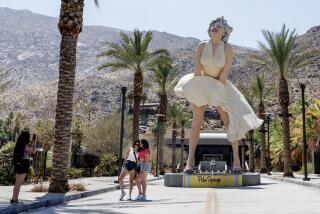Deal averts lawsuit that threatened to stall Academy Museum of Motion Pictures
The Academy Museum of Motion Pictures has ducked a threatened lawsuit over traffic, parking and intrusive signage that could have stalled the project in court. An agreement reached with the citizens’ group Fix the City clears the way for it to begin construction on a site next to the Los Angeles County Museum of Art.
Fix the City, a nonprofit group that fights development in L.A. that it considers damaging to neighborhoods, had objected to the $300-million movie museum’s impact on traffic in the Miracle Mile area.
But Fix the City President Mike Eveloff issued a written announcement Thursday night saying that it has hashed out a “settlement agreement” with the film academy that assuages its concerns.
SIGN UP for the free Essential Arts & Culture newsletter >>
The academy confirmed the agreement Friday morning. Museum spokesman Morgan Kroll said the academy “received a demolition/alteration permit from the city this week, and demolition — the first stage of construction — begins this fall.”
Leaders of the film museum’s parent organization, the Oscars-conferring Academy of Motion Picture Arts and Sciences, received city approval for the project in June but had held off on a hoped-for summer construction start while talks with Fix the City continued. The academy is aiming for a late-2017 museum opening.
Fix the City’s announcement said that it and the Academy Museum have developed “innovative” systems to monitor traffic flow and strains on the museum’s parking capacity, triggering agreed-upon measures to relieve problems when they arise.
“All monitoring is privately operated and mechanisms for enforcement ... do not rely on the city,” the announcement said, without going into specifics about how the system would work.
In Fix the City’s written announcement, board member Laura Lake borrowed a catchphrase from one of Hollywood’s most important figures, Ronald Reagan: “The settlement agreement embodies a trust but verify approach with built-in mechanisms to fix impacts rather than have them be merely a cost of doing business,” she said. “Fix the City appreciates the academy’s willingness to think outside the box.”
When Reagan was negotiating nuclear arms agreements with the Soviet Union during his Cold War presidency, he said he’d be guided by an old Russian proverb: “Trust but verify.”
The museum plan OK’d in late June by the City Council did not require the Academy Museum to install any new parking, despite projections that it will attract more than 2,000 visitors on an average day, and as many as 5,000 on peak days. It will share LACMA’s existing parking garage and surface lot.
Critics were especially concerned about traffic crunches when the Academy Museum hosts special events, such as film premieres in the 1,000-seat spherical, see-through cinema it will build next to the museum that will be carved out of the 1939-vintage former May Co. department store at Wilshire Boulevard and Fairfax Avenue.
The academy responded by saying it had agreements to lease more than 800 additional parking spaces from neighboring office buildings and the Petersen Automotive Museum to accommodate any overflow.
Signage was another concern for Fix the City, which showed its clout several years ago when it beat the city in court in a lawsuit that overturned a new zoning plan that would have allowed more intense development in Hollywood.
According to the announcement, the academy has agreed not to put previously planned advertising banners along Fairfax next to the cinema sphere and to ensure that a “large digital sign” on the Wilshire side of the sphere won’t be visible to motorists.
The agreement allows for digital signs along Wilshire in what were once department store display windows. It also OKs the giant Oscar statuette the academy hopes to hoist as a marker in front of the tall, gold-and-black art deco column at Fairfax and Wilshire that is the historic building’s most distinctive architectural feature.
Follow @boehmm of the L.A. Times for arts news and features
More to Read
The biggest entertainment stories
Get our big stories about Hollywood, film, television, music, arts, culture and more right in your inbox as soon as they publish.
You may occasionally receive promotional content from the Los Angeles Times.











